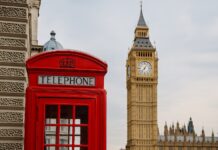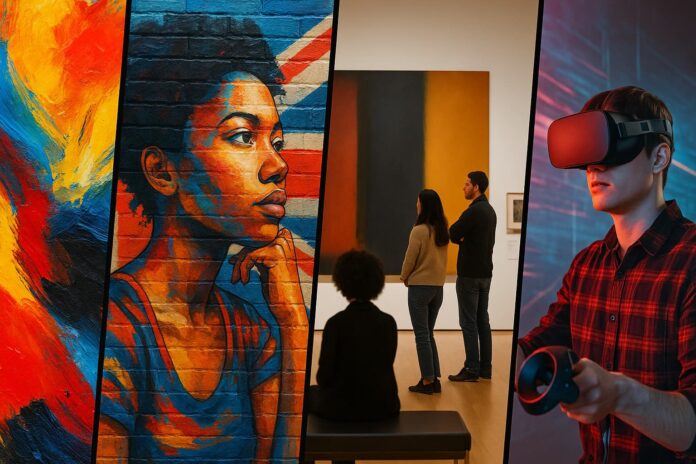Modern British art is living through a golden era of reinvention. From experimental installations in London to digital art collectives in Bristol, creativity is reshaping what it means to be British. Today’s artists blend heritage with innovation, turning art into a powerful reflection of a nation in transformation.
Introduction: The New Voice of British Creativity
The United Kingdom has always been known as a cradle of artistic brilliance. From Turner’s romantic seascapes to Hockney’s vivid modernism, British art has shaped global imagination for centuries. But in the 21st century, the conversation has shifted — from preserving legacy to redefining identity.
Modern British art today represents a mosaic of cultures, ideas, and stories. It is deeply inclusive, politically aware, and technologically advanced. Artists are using everything from paint and performance to artificial intelligence and social media to express their visions. This transformation mirrors the country’s broader evolution — from empire and tradition to diversity and dialogue.
I. The Historical Backdrop: Roots of a Creative Nation
From Empire to Expressionism
Britain’s artistic tradition has long mirrored its social and political landscape. The 18th and 19th centuries celebrated realism and grandeur, showcasing national pride through portraits and landscapes. As the 20th century unfolded, British artists began to question those conventions — giving rise to modernist movements, surrealism, and abstract experimentation.
The Postwar Creative Awakening
After World War II, Britain faced both reconstruction and reinvention. Artists like Henry Moore and Barbara Hepworth brought abstraction into public consciousness, blending human emotion with industrial minimalism. Their work symbolised renewal — the art of resilience in a nation rebuilding its spirit.
II. The Bold 1990s: The YBA Revolution
The Rise of the Young British Artists (YBAs)
In the 1990s, a new generation of artists disrupted tradition. The Young British Artists — including Damien Hirst, Tracey Emin, Sarah Lucas, and others — redefined the meaning of art itself. Their provocative installations and conceptual pieces challenged moral norms, commercialism, and the establishment.
Cultural Shock Meets Global Spotlight
From Hirst’s preserved animals to Emin’s My Bed, their work was raw, fearless, and unapologetically British. It placed the UK at the heart of global contemporary art and inspired a culture of bold self-expression that continues to influence artists today.
III. Modern British Art in the 21st Century
Diversity as the New Identity
Contemporary British art is as diverse as the people creating it. Artists from African, South Asian, and Caribbean backgrounds bring fresh narratives that challenge traditional definitions of “Britishness.” Lubaina Himid, the first Black woman to win the Turner Prize, and Yinka Shonibare, known for exploring colonialism and identity, represent this new wave.
Art Beyond Borders
Post-Brexit Britain has sparked deep reflection among artists. Many works now explore themes of belonging, migration, and cultural memory. Art becomes not just expression, but exploration — of what unites and divides the modern British experience.
IV. Technology and Innovation in Art
The Rise of Digital Creativity
From 3D printing to VR exhibitions, technology has become a vital medium for expression. Artists use AI to create interactive experiences that engage viewers in new dimensions. The Barbican Centre and the Design Museum have hosted several exhibitions showcasing this fusion of art and technology.
NFTs and the New Art Economy
Digital ownership has revolutionised how art is valued. British artists are at the forefront of the NFT (non-fungible token) movement, where digital artworks are authenticated and sold globally — democratising access to art while redefining the collector’s market.
Social Media as the Modern Gallery
Instagram and TikTok have become the exhibition halls of the digital generation. Artists like Charlotte Keates and Joy Yamusangie use social media not only to showcase work but to build communities and challenge elitist boundaries in the art world.
V. Regional Creativity: Beyond the London Art Scene
The Northern Renaissance
While London remains the UK’s cultural hub, regional cities are rising fast. Manchester’s HOME arts centre, Leeds’ Tetley Gallery, and Glasgow’s CCA (Centre for Contemporary Arts) are transforming local art ecosystems. These creative hubs celebrate local identity while connecting to international audiences.
Street Art and Public Expression
Cities like Bristol, home of the enigmatic Banksy, have turned street art into global phenomena. Public murals tackle issues from climate change to equality, making art part of everyday life. These works reclaim urban spaces, transforming walls into voices of the people.
VI. British Art as a Social Mirror
Exploring Gender, Race, and Class
Contemporary art in the UK increasingly serves as social commentary. Artists like Zadie Xa and Rana Begum explore themes of gender, race, and migration, blending traditional materials with modern design. Their art opens conversations around representation and inclusion in British society.
Environmental and Climate Art
The UK’s climate activism has found strong expression through art. From the “Art for Earth” exhibitions to sculptures using recycled materials, modern artists are voicing ecological concerns through creativity, urging viewers to rethink their relationship with nature.
VII. Institutions, Galleries, and Global Influence
The Role of the Tate and the Turner Prize
Institutions like the Tate Modern, Saatchi Gallery, and Serpentine Galleries continue to shape artistic discourse. The Turner Prize, one of the world’s most influential awards, now celebrates diversity, activism, and innovation rather than just aesthetics — reflecting Britain’s evolving cultural conscience.
British Art on the Global Stage
From the Venice Biennale to New York’s MoMA, British artists are recognised for their boldness and originality. Their work acts as cultural diplomacy — expressing Britain’s creative soul while promoting dialogue across nations.
VIII. The Economics of Creativity
The Creative Industries as a Growth Engine
The UK’s creative industries contribute over £100 billion annually to the economy. Art and design education, cultural tourism, and public art funding have become vital for regional development. Cities like Edinburgh, Liverpool, and Birmingham now see art as an investment in identity and innovation.
Government and Private Support
Public funding through Arts Council England and private patronage from organisations like Frieze London play crucial roles in nurturing emerging talent. This ecosystem ensures art remains both accessible and sustainable.
IX. Education, Youth, and the Next Generation
Cultivating Creativity in Schools
Modern British art is also influencing education. Universities such as Central Saint Martins and the Royal College of Art are producing world-class talent in fine arts, animation, and design. There’s a growing push to make creative education central to national development.
Youth Movements and Grassroots Art
Pop-up exhibitions, community art workshops, and youth collectives in cities like Sheffield and Liverpool are empowering young artists. These initiatives encourage storytelling, empathy, and innovation — ensuring Britain’s artistic legacy evolves with time.
X. Challenges and Opportunities Ahead
Balancing Heritage and Innovation
The challenge for British art lies in maintaining respect for its classical roots while embracing new ideas. Artists must navigate the tension between preservation and progress, balancing heritage with experimentation.
Art Accessibility and Inclusion
Despite digital advances, socioeconomic barriers persist. Ensuring equal access to galleries, education, and funding remains essential to preserving Britain’s creative democracy.
FAQs
1. What defines modern British art and how has it evolved?
Modern British art is defined by diversity, experimentation, and self-reflection. It has evolved from the classical portraiture of empire to the conceptual dynamism of today’s globalised Britain. Artists now explore themes of identity, race, environment, and technology, reflecting the country’s transformation from a colonial power to a multicultural democracy. This evolution also represents a shift in medium — from oil on canvas to installations, photography, and digital expression. It’s less about prestige and more about participation, giving voice to everyday realities and collective experience.
2. How does modern British art shape and reflect national identity?
Modern art acts as a cultural mirror — it reveals how Britain sees itself in a changing world. The fusion of heritage with global influences has created an artistic language that celebrates difference while searching for unity. Through their work, artists question colonial history, class structures, and post-Brexit identity. Exhibitions across the UK showcase this ongoing dialogue between past and present, reflecting how creativity defines national spirit. British art today isn’t about conformity; it’s about inclusivity and conversation, turning creative expression into an evolving narrative of belonging.
3. Who are the leading figures in modern British art today?
The UK’s creative landscape includes both renowned icons and rising innovators. Established names such as Banksy, Tracey Emin, Damien Hirst, and Anish Kapoor remain influential for their bold styles and provocative concepts. Meanwhile, new-generation artists like Lubaina Himid, Yinka Shonibare, and Joy Yamusangie are reshaping the field with perspectives rooted in identity, heritage, and activism. Performance artists like Sin Wai Kin and digital creators merging AI with fine art are also redefining creativity for the modern age. Together, they prove that British art is not confined to tradition but thrives on reinvention.
4. How has technology transformed British creativity?
Technology has revolutionised how art is made, shared, and experienced. British artists now work with AI, augmented reality, and digital fabrication, creating immersive works that merge science with emotion. Virtual galleries and NFTs enable new ways of ownership and engagement, while platforms like Instagram turn ordinary users into curators. This digital shift has democratised access, allowing artists to reach audiences beyond galleries. It’s also encouraging sustainability — reducing physical waste and expanding art’s environmental responsibility. Technology hasn’t replaced human creativity; it has amplified it, pushing British art into new frontiers of imagination.
5. Why is regional and community art vital to the UK’s cultural landscape?
Regional art gives voice to local stories and experiences, ensuring British culture remains inclusive and diverse. Cities like Manchester, Bristol, and Glasgow are driving creative decentralisation through public art, murals, and grassroots exhibitions. These movements transform neglected spaces into hubs of dialogue and pride. Street art, community collectives, and regional galleries engage audiences who might never step into traditional museums. This democratisation of creativity is essential — it keeps art grounded in people’s daily lives, making culture a shared national asset rather than a privilege for the few.
6. How do British artists use their work to address social and political issues?
British artists have long used creativity as a tool of activism. From confronting colonial legacies to highlighting gender inequality and climate change, art has become a visual language of resistance. Installations in major cities often spark conversations about justice, migration, and inclusivity. Artists like Jeremy Deller and Gillian Wearing combine political narrative with public engagement, turning spectators into participants. By addressing issues that shape everyday life, British art transcends aesthetics — it becomes a force for empathy, awareness, and reform, ensuring that art and society evolve together.
7. What does the future of modern British art look like?
The future of British art lies in hybrid creativity — where technology, sustainability, and cultural diversity intersect. As young artists blend digital tools with traditional mediums, the boundaries between fine art, design, and activism will continue to blur. Public funding, art education, and inclusion will play vital roles in nurturing new voices. Britain’s future identity — open, questioning, and creative — will be expressed through art that unites rather than divides. Expect more immersive exhibitions, AI collaborations, and environmental storytelling that make creativity central to both citizenship and culture.
Conclusion: Art as the Soul of a Changing Nation
Modern British art is not just an aesthetic pursuit — it is a cultural compass. It reflects the aspirations, struggles, and diversity of a nation constantly redefining itself. Through innovation, inclusivity, and storytelling, art captures the pulse of Britain’s transformation.
As technology, migration, and social change reshape the nation, creativity becomes its common thread. Whether on canvas or in code, British artists continue to challenge convention, question identity, and celebrate the human spirit. Their work stands as a testament to Britain’s enduring truth: that art is not merely seen — it is lived.






















